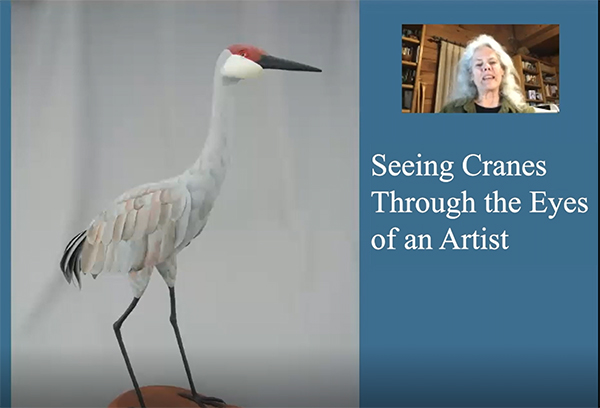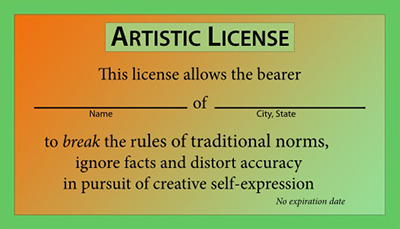[vc_row][vc_column][vc_column_text]Our Education and Outreach teams at the International Crane Foundation hope that you and your family have been enjoying our weekly Quarantine with Cranes activities. Today we welcome you to an incredibly exciting art edition of Quarantine with Cranes. We reached out to Kim Russell, a Wisconsin-based artist. She generously agreed to create some resources for you to learn about an artist’s perspective on cranes. Most of the activities in this post are her creations.
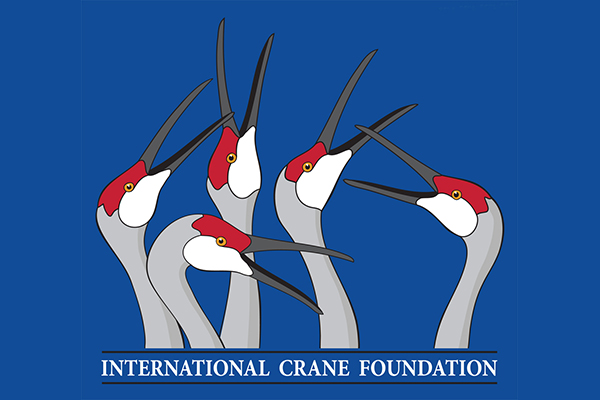
Kim Russell makes stylized drawings of birds in ink and acrylic paints. In order to portray their distinctive characteristics and habits, she studies her subjects until they feel familiar. As a result of her research and observation, her dedication to birds has become a lifelong passion. In this lesson, she shares her fascination with the hopes it will stimulate you to learn more about the natural world in which you live. You can visit her website at russellworks.com.
Activity description: Kim Russell has created an educational video, a quiz and a Sandhill Crane pop-up card. She also has provided suggestions for videos other artists created to give bird drawing tips. Scroll down to the workplan to learn more about each of these materials.
Grades: All ages, including adults
Time estimate: Two hours
Topics covered: Art, artistic license, creativity, crane behavior, crane morphology and crane biology
Materials needed: Internet access, printer, one 8.5″ x 11″ sheet of heavy paper (like card stock), colored pencils, crayons or paint, scissors, glue stick or double-sided tape, one sheet of construction paper (or other heavy colored paper) and decorative paper edge scissors (optional)
Adult involvement: Not necessary, but strongly encouraged
Indoor or outdoor: Both – we encourage you to observe the special characteristics of birds and then draw them!
Links:
Seeing Cranes Through an Artist’s Eyes: Kim Russell Crane Presentation
Sandhill Crane pop-up card instructions
Sandhill Crane pop-up template
How to Sketch Birds by Artist John Muir Laws
Workplan: Begin by watching Seeing Cranes Through an Artist’s Eyes: Kim Russell Crane Presentation. You will hear Kim Russell discuss how she learns about cranes through art, using a sample of some of her artwork to showcase how her crane observations have influenced her work. Make sure to pay attention to Kim Russell’s thoughts on the differences between mistakes and artistic license. After watching the video you can print out your own artistic license! Click here to download a printable version of the license.
Now take a look at the quiz questions below. The quiz is based on interesting facts Kim Russell has learned researching Sandhill Cranes while preparing to create artwork. These questions will get you thinking about some of the special characteristics of Sandhill Cranes. It is okay if you do not know all the answers at first. The quiz will help you learn.[/vc_column_text][/vc_column][/vc_row][vc_row][vc_column][vc_tta_accordion style=”flat” active_section=”1″ collapsible_all=”true”][vc_tta_section title=”Quiz” tab_id=”1590703551185-6fc820fe-5440″][vc_column_text]1.) What does the back of a Sandhill crane’s head look like?
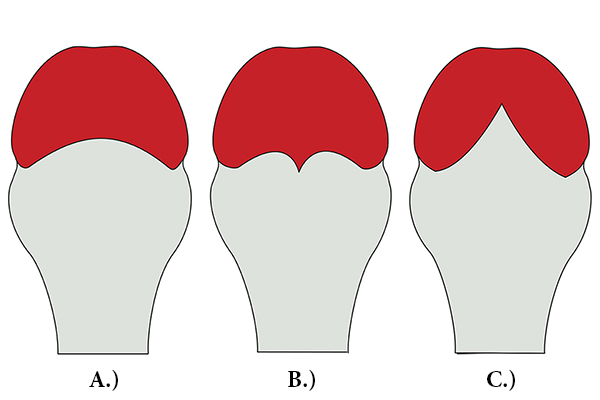
2.) What is wrong with the feet on this sculpture of a Sandhill Crane?
A.) There are not enough toes.
B. ) The back toe is too long.
C.) Cranes don’t have a back toe.
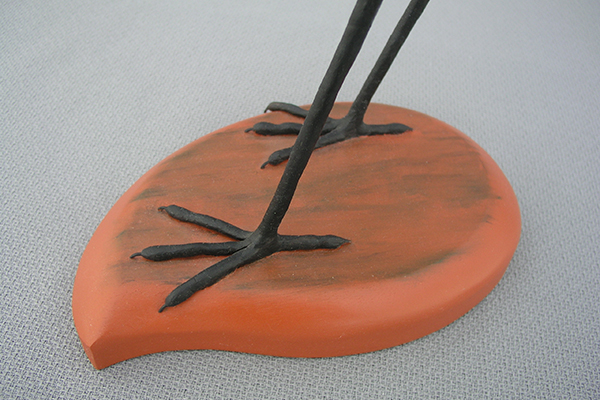
3.) Why are some Sandhill Cranes gray, while others are brown?
A.) All Sandhill Cranes are gray, but some paint themselves with brown mud.
B.) Gray cranes have low levels of brown pigment due to inadequate iron in their diet.
C.) In some areas, cranes roll in clover. The brown clover pollen colors their feathers.
4.) Where do Sandhill Cranes like to roost at night?
A.) On the top branches of pine trees
B.) Standing in water
C.) In the middle of cornfields
5.) Sandhill Cranes dance:
A.) With a partner
B.) With their offspring
C.) Solo
D.) All of the above
6.) What is the red patch on top of a Sandhill Crane’s head?
A.) Tiny red feathers
B.) Bumpy bare skin
C.) Little red hats attached by researchers to distinguish cranes from herons
[/vc_column_text][/vc_tta_section][vc_tta_section title=”Quiz Answers” tab_id=”1590703551272-d7def22e-4ca8″][vc_column_text]1.) The correct answer is C. Are you surprised by that?
2.) B. Sandhill Cranes have a short, stubby back toe.
3.) A. Sandhill Crane’s natural color is gray. In some areas, the cranes will dip their beaks in iron-rich, reddish-brown mud and rub it on their feathers as they preen themselves. The feathers are stained brown throughout the breeding season, but in the fall, when they molt, they lose their old feathers and grow fresh, new ones before they migrate. Then their bodies are all gray again.
4.) B. Since the Sandhill Crane’s back toe is so short the crane can’t grip onto branches to perch in trees. Of the 15 species of cranes in the world, the two crowned cranes species of Africa are the only cranes with a back toe long enough to allow them to perch in trees. At night, in order to protect themselves from predators, Sandhill Cranes walk out into water about 10 inches deep. They stand on one leg, with the other leg tucked up close to their bodies to keep warm.
5.) D. ALL the answers are correct! Cranes will leap in the air, bow and twirl with their partners. They will also dance with their offspring to teach them how to dance. And, sometimes they just leap and dance out of pure exuberance.
6.) B. The red patch is bumpy bare skin. The patch of skin will pull back and enlarge when the crane is agitated. When the bird is calm, the skin relaxes so the patch is smaller.[/vc_column_text][/vc_tta_section][/vc_tta_accordion][/vc_column][/vc_row][vc_row][vc_column][vc_column_text]After you finish this quiz, pick a different bird and make up your own quiz to give your friends and family. Research the bird until you find six interesting facts about it.
Now it is time to make a Sandhill Crane pop-up card. Click on the instructions here and then click here to download the drawing you’ll print out to make the card. You can also scroll back up to the “materials needed” section to look at a list of other materials you will need to make the card. Think back to Kim Russell’s advice about using artistic license, while keeping the distinguishing features of the bird. Sandhill Cranes have several distinctive features, including their colors, which is why the instructions tell you the colors you should use for your pop-up card. Once you complete the card it will look similar to the two pictures below. As the instructions sheet mentions, try making another pop-up card with a different bird, too.
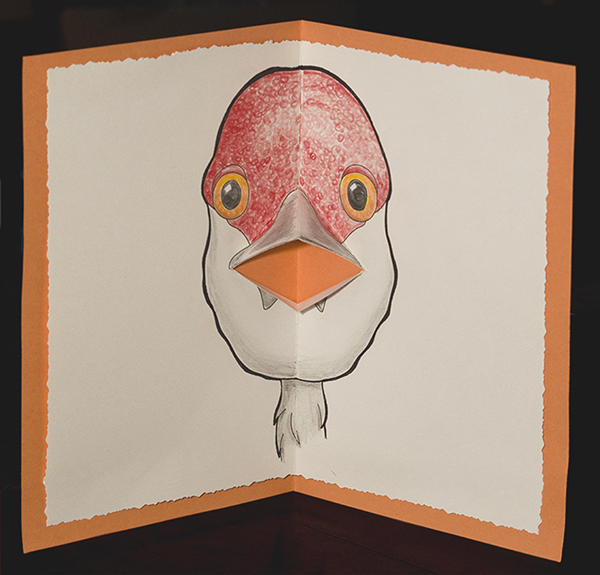
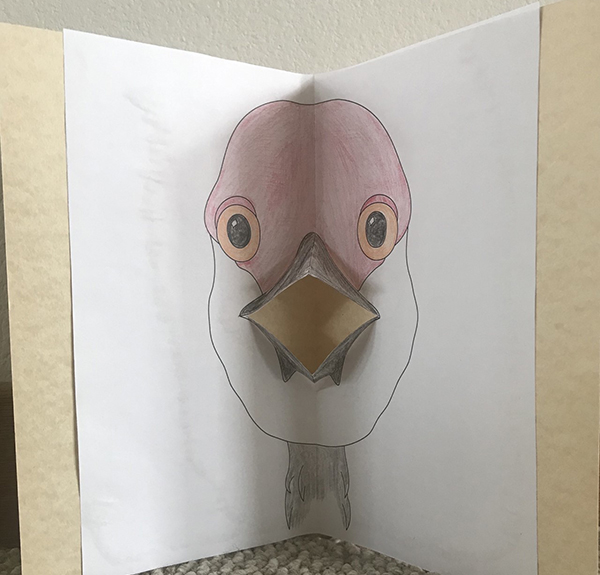
Kim Russell also recommends the following for learning tips on how to draw birds. Here is what she has to say:
“If you would like to learn about drawing birds, there are lots of good books at the library and videos online for all levels. John Muir Laws is a respected artist, who really knows birds, and has many wonderful videos about how to draw – even one that’s over an hour long that teaches how to draw cranes. Give this one a try, for a start. Before you watch, learn what a bird’s coverts are, so you know what he’s referring to. There are upperwing and underwing coverts, and uppertail and undertail coverts.”
Special Announcement:
We are excited to announce an upcoming From the Field Series presentation on cranes in art! “Cranes and Artists – A Creative Dance” is a collaborative webinar between the Leigh Yawkey Woodson Art Museum in Wausau, Wisconsin and the International Crane Foundation. Check out the Woodson Art Museum’s website at lywam.org and join us for this webinar on Thursday, June 18 at 11 a.m. Central Time. You can register for the webinar starting June 2.
We would like to share some videos from the Woodson Art Museum to get you excited about this webinar and get you thinking about art interpretation. Some of the artists in these videos bring up themes Kim Russell focused on for this lesson. Look for moments where the artists mention artistic license and the relationship between art and science. How do these artists’ comments relate to Kim Russell’s thoughts in her video?
Kent Ullberg on “Rites of Spring” at the Woodson Art Museum
Robert Bateman on Young Sandhill Cranes
The Myth Makers on “The Dance,” Woodson Art Museum
[/vc_column_text][/vc_column][/vc_row]

